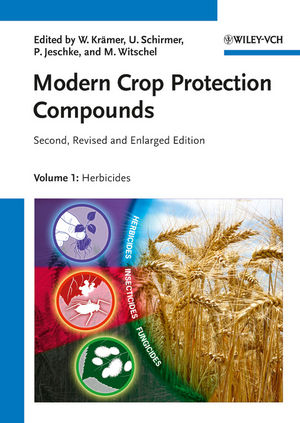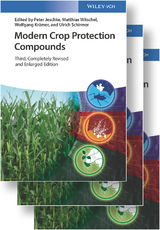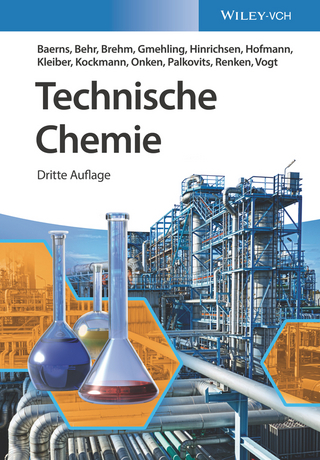
Modern Crop Protection Compounds
Wiley-VCH (Verlag)
978-3-527-32965-6 (ISBN)
- Titel erscheint in neuer Auflage
- Artikel merken
This one-stop reference for everyone working in the agrochemical business is the leading reference in the field, with first-class authors from all major crop protection companies, including Bayer, Dow, Syngenta and BASF. In three volumes, one each on herbicides, fungicides and insecticides, it provides up-to-date information on the chemical properties, mode of action, range of application, industrial-scale synthesis and commercial products. The new edition has been updated and expanded by more than 50 new compounds and their mechanisms, for a complete picture of agrochemicals introduced since 1990.
A truly comprehensive source of top quality information.
Wolfgang Krämer gained his PhD in organic chemistry from the TU Stuttgart (Germany) in 1968, after which he joined the Institute of Textile Chemistry at Stuttgart University, bevore moving to Bayer Plant Protection as lab leader in plant protection research in 1970. Between 1984 and 1990 he was Head of Global Chemistry Fungicides, and Head of Insecticide Chemistry thereafter.Retired since 2005, Dr. Krämer has over 250 patent applications and publications to his name. Ulrich Schirmer received his PhD in organic chemistry from Stuttgart University (Germany) in 1973, and subsequently carried out his postdoc at Paris-Orsay (France). He joined BASF in 1974, eventually becoming Senior Vice President responsible for plant protection research for chemical synthesis, process development and biological R&D. Since 2003, he has been working as a freelance consultant to start-ups in the fields of biotechnology, chemistry and agriculture. Dr. Schirmer is author and co-author of more than 100 patent applications and scientific publications. Peter Jeschke gained his PhD in organic chemistry at the University of Halle/Wittenberg (Germany), after which he moved to Fahlberg-List Company (Germany) to pursue agrochemical research before going to the Institute of Neurobiology and Brain Research, German Academy of Sciences. In 1989 je joined Bayer as lab leader in animal health research and eight years later he took a position at the Bayer Crop Protection Business Group, where he is currently Head of Research Pest Control Chemistry 2. Since 2011, he is honorary professor at the University of Düsseldorf (Germany). Prof. Dr. Jeschke has more than 180 patent applications and scientific publications to his name. Matthias Witschel received his PhD in organic chemistry in 1994 at the University of Erlangen-Nürnberg (Germany). After his post-doctoral stay at Stanford University, California (USA), he started in 1996 at BASF in herbicide research, where he is now Principal Scientist in the Global Research Herbicides, Agricultural Products, based in Ludwigshafen (Germany). Dr. Witschel is the author and co-author of over 160 patents and scientific publications.
VOLUME 1: HERBICIDES
Overview
HRAC CLASSIFICATION OF HERBICIDES AND RESISTANCE DEVELOPMENT
Introduction
HRAC Classification System of Herbicides
Herbicide Resistance
ACETOHYDROXYACID SYNTHASE INHIBITORS (AHAS/ALS)
Biochemistry of the Target and Resistance
Newer Sulfonylureas
Imidazolinone Herbicides
Triazolopyrimidines
Pyrimidinylcarboxylates and Sulfonanilides
Sulfonylaminocarbonyl-Triazolinones
PROTOPORPHYRINOGEN IX OXIDASE INHIBITORS
Introduction
Historical Development
Non-Classical Protox Chemistries
Recent Developments
Toxicology
Summary
HERBICIDES WITH BLEACHING PROPERTIES
Phytoene Desaturase Inhibitors
Hydroxyphenylpyruvate Dioxygenase (HPPD): The Herbicide Target
Triketones
Hydroxyphenylpyruvate Dioxygenase (HPPD) Inhibitors: Heterocycles
NEW AUXIN MIMICS AND HERBICIDES
The Molecular Mode of Action of Auxin Herbicides
Aminopyralid
Pyrimidine Carboxylic Acids, Aminocyclopyrachlor
HERBICIDES DISTURBING THE SYNTHESIS OF VERY LONG-CHAIN FATTY ACIDS (VLCFAs)
Inhibitors of the Synthesis of Very Long-Chain Fatty Acids (VLCFAs)
Chemistry and Biology of Oxyacetamides, Tetrazolinones, and Triazolinones
Isoxazolines
INHIBITORS OF CELLULOSE BIOSYNTHESIS
Introduction
Cellulose Biosynthesis Inhibitors from Different Chemical Substance Classes
Cellulose Biosynthesis Inhibitors from Natural Sources
SAFENERS FOR HERBICIDES
Introduction
Overview of Selected Safeners
Mechanisms of Herbicide Safener Action
Mode of Action of Safeners in Agricultural Practice
Concluding Remarks
GENETICALLY MODIFIED HERBICIDE-RESISTANCE CROPS
Overview
Inhibitors of 5-Enolpyruvyl Shikimate 3-Phosphate Synthase (EPSPS)
Glutamine Synthetase Inhibitors
MICROTUBULIN ASSEMBLY INHIBITORS (PYRIDINES)
Introduction
Biology of the Microtubulin Assembly Inhibitors (Pyridines)
Environmental Fate of Microtubulin Assembly Inhibitors (Pyridines)
Toxicology of Microtubulin Assembly Inhibitors (Pyridines)
Mode of Action of Microtubulin Assembly Inhibitors (Pyridines)
Synthesis of Dithiopyr and Thiazopyr
ACETYL-CoA CARBOXYLASE INHIBITORS
Introduction
Biochemistry
Chemistry of ACCase Inhibitors
Structure-Activity Relationships
Pinoxaden
Summary and Outlook
PHOTOSYNTHESIS INHIBITORS: REGULATORY ASPECTS, RE-REGISTRATION IN EUROPE, MARKET TRENDS, AND NEW PRODUCTS
Introduction
The Re-Registration in the European Union
Main Changes in Guidelines Regarding EU RE-Registration
New Regulations in Europe
Situation of PS II Inhibitors in the EC Markets
Current Market Share of PS II Compound Groups
A New Herbicide for Corn and Sugarcane: Amicarbazone - BAY MKH
Conclusions
NEW ASPECTS OF PLANT REGULATIONS
Introduction
Plant Growth Regulators
PGRs in Modern Agriculture
Conclusions and Developments
VOLUME 2: FUNGICIDES
Overview
FRAC MODE OF ACTION CLASSIFICATION AND RESISTANCE RISK OF FUNGICIDES
History of Fungicide Use
Fungicides: Importance of Individual Modes of Action
Fungicide Resistance
Fungicides Classes and Modes of Action
FUNGICIDES ACTING ON OXIDATIVE PHOSPHORYLATION
The Biochemistry of Oxidative Phosphorylation: A Multiplicity of Targets for Crop Protection Chemistry
Strobilurins and Other Complex III Inhibitors
Succinate Dehydrogenase Inhibitors
Uncouplers of Oxidative Phosphorylation
NADH Inhibitors (Complex I)
FUNGICIDES ACTING ON AMINO ACIDS AND PROTEIN SYNTHESIS
Natural Compounds Used in Agriculture Interfering in Protein Synthesis of Fungi and Bacteria
Anilinopyrimidines: Methionine Biosynthesis Inhibitors
FUNGICIDES ACTING ON SIGNAL TRANSDUCTION
Mode of Action
Chemistry and Biology of Fludioxonil, Fenpiclonil, and Quinoxyfen
FUNGICIDES ACTING ON MITOSIS AND CELL DIVISION
Zoxamide: An Antitubulin Fungicide for the Control of Oomycete Pathogens
Pencycuron: A Phenylurea Fungicide for Rhizoctonia solani
STEROL BIOSYNTHESIS INHIBITORS
Sterol Biosynthesis Inhibitor SBI Fungicides in Agriculture
SBI Class I: DMI Fungicides
SBI Class II: Amines
SBI Class III: Hydroxyanilides
SBI Class IV: Squalene Epoxidase Inhibitors
CARBOXYLIC ACID AMIDE (CAA) FUNGICIDES
Introduction
Chemistry of the Carboxylic Acid Amides
Biological Activity of Carboxylic Acid Amides
Mode of Action and Mechanism of Resistance of the CAA Fungicides
FLUOPICOLIDE: A NEW ANTI-OOMYCETES FUNGICIDE?
Introduction
Chemical and Physical Properties
Toxicology/Ecotoxicology
Spectrum of Activity
Effect of Fluopicolide on Spectrin-Like Protein Distribution
Conclusion
MELANIN SYNTHESIS IN THE CELL WALL
Biological Occurrence and Function of Melanin in Fungi
Overview: Fungicides Inhibiting DHN Melanin Biosynthesis
Biology of Scytalone Dehydratase Inhibitors
Biochemical Reaction Mechanim of Scytalone Dehydratase and Structure-Based Inhibitor Design
Chemistry and Stereochemistry of Carpropamid
Resistance Problems and Successful Management in Japan
Final Remarks
FUNGICIDES WITH UNKNOWN MODE OF ACTION
Introduction
Cymoxanil
Fosetyl-Aluminum
Flusulfamide
Diclomezine
Triazoxide
Tebufloquin
RECENTLY INTRODUCED POWDERY MILDEW FUNGICIDES
Introduction
Cyflufenamid
Metrafenone
Pyriofenone
Proquinazid
Flutianil
Conclusions
NEWEST ASPECTS OF NUCLEIC ACID SYNTHESIS INHIBITORS: METALAXYL-M
Introduction
Chemistry of Metalaxyl-M/Mefenoxam
Biological Activity
Mode of Action and Mechanism of Resistance
Degradation and Metabolism of the Two Enantiomers
HOST DEFENSE INDUCERS
Introduction
General Mechanism of Induced Resistance
Market Products
Summary and Outlook
VOLUME 3: INSECTICIDES
Overview
IRAC: Insecticide Resistance, and Mode of Action Classification of Insecticides
Introduction
Objectives of the IRAC
Structure and Organization of the IRAC
Activities
Principles of Resistance
The Mode of Action (MoA) Classification Scheme v7.0, August 2010
Effective IRM Strategies and Approved Principles
Future Market Trends
Conclusions
INSECT MOLTING AND METAMORPHOSIS
Bisacylhydrazines: Novel Chemistry for Insect Control
Pyriproxyfen: A New Juvenoid
CHITIN SYNTHESIS
Chitin Synthesis and Inhibitors
Mite Growth Inhibitors: Clofentezine, Hexythiazox, Etoxazole
MIDGUT - TRANSGENIC CROPS EXPRESSING Bacillus thuringiensis CRY PROTEINS
Introduction
Plant Engineering
Insecticidal Crystal Proteins from B. thuringiensis
Bt Plants
Insect Resistance to Bt
Resistance Management with Bt Plants
Safety of Bt Plants
Conclusions
METABOLIC PROCESSES
Inhibitors of Oxidative Phosphorylation
Inhibitors of Oxidative Phosphorylation via Disruption of the Proton Gradient
Inhibitors of Mitochondrial Electron Transport: Acaricides and Insecticides
Inhibitors of Lipid Synthesis: Acetyl-CoA-Carboxylase Inhibitors
NERVOUS SYSTEM
Nicotinic Acetylcholine Receptor Agonists: Target and Selectivity Aspects
Chemical Structural Features of Commercialized Neonicotinoids
Sulfoxaflor
Spinosad and Spinetoram, a New Semi-Synthetic Spinosyn
Sodium Channel-Blocking Insecticides
Ligand-Gated Chloride Channel Antatgonists (Fiproles)
Chloride Channel Activators/New Natural Products: Avermectins and Milbemycins
NEW UNKNOWN MODES OF ACTION
Selective Feeding Blockers: Pymetrozine, Flonicamid, and Pyrifluquinazon
Acaricides with Undefined Mode of Action: Bifenazate, Cyflumetofen, and Amidoflumet
Pyridalyl: Discovery, Insecticidal Activity, and Mode of Action
Recent Nematicides
INSECTICIDES AFFECTING CALCIUM HOMEOSTASIS
Ryanodine Receptor Modulators: Diamides
Flubendiamide
Anthranilic Diamide Insecticides: Chlorantraniliprole and Cyantraniliprole
Index of Common Names
Subject Index
"Modern crop protection compounds is a comprehensive source of accumulated information about modern agrochemicals and the research that led to their use in agriculture." ( Chemistry & Industry , 1 October 2012)
| Erscheint lt. Verlag | 14.12.2011 |
|---|---|
| Verlagsort | Weinheim |
| Sprache | englisch |
| Maße | 170 x 240 mm |
| Gewicht | 3538 g |
| Themenwelt | Naturwissenschaften ► Chemie ► Technische Chemie |
| Weitere Fachgebiete ► Land- / Forstwirtschaft / Fischerei | |
| Schlagworte | Agriculture • agrochemicals • Agrochemikalien • Biowissenschaften • Botanik • Chemie • Chemistry • Getreide • Landwirtschaft • Life Sciences • Organic Chemistry • Organische Chemie • Pests, Diseases & Weeds • Pests, Diseases & Weeds • Pflanzenschutz • Pflanzenschutzmittel • plant science • Schädlinge, Krankheiten u. Unkräuter • Technische Chemie |
| ISBN-10 | 3-527-32965-X / 352732965X |
| ISBN-13 | 978-3-527-32965-6 / 9783527329656 |
| Zustand | Neuware |
| Informationen gemäß Produktsicherheitsverordnung (GPSR) | |
| Haben Sie eine Frage zum Produkt? |
aus dem Bereich



